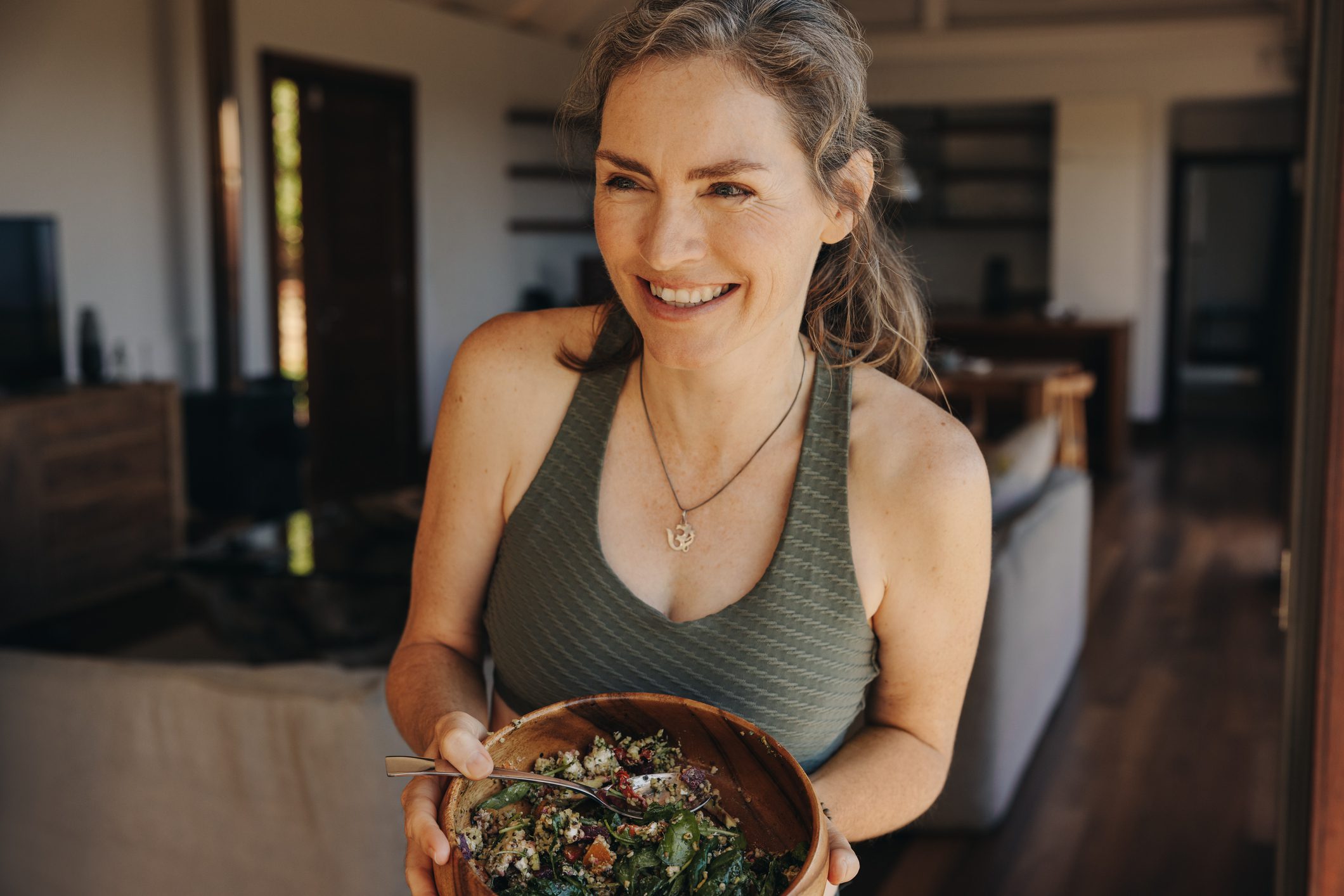Fiber offers numerous health benefits as it moves through your digestive tract. Far from simply giving you poops to be proud of (which it does very well), fiber supports nearly every system in your body.
Fiber is a type of carbohydrate found in plant foods. It comes in several types but also acts as a prebiotic, which feeds beneficial gut bacteria that are necessary for a healthy gut microbiome.1
The benefits of fiber are wide-ranging beyond gut health, and it’s one of your biggest allies when it comes to fat loss. High-fiber foods help you feel fuller longer, avoid cravings and stabilize blood sugar by slowing down the absorption of carbohydrates into your bloodstream. This reduces the risk of insulin spikes that can contribute to weight-loss resistance.2
Fiber also helps normalize cholesterol levels, lower your risk of heart disease, and manage inflammation.3, 4 It is also necessary for hormone balance, binding and eliminating toxins, and removing excess hormones (like estrogen) to keep them from being reabsorbed into the body.5
How Much Fiber Do You Need?
The American Heart Association recommends that women get 25 grams of fiber per day. Studies show that only 9% of women meet that daily quota, and the average American only gets about 15 grams.
I want you to aim higher with 50 grams per day. (Think that’s high? Researchers believe that our Paleolithic ancestors ate around 100 grams of fiber daily!) Studies show that people who eat 50 grams of fiber daily get more benefits, including a lower risk of colon cancer.6-9
Fiber comes in two types: soluble and insoluble. Soluble fiber dissolves in water and forms a gel-like substance in your digestive tract, helping to regulate blood sugar and cholesterol levels. Good sources of soluble fiber include oats, fruit, and vegetables.10
Prebiotics are a unique kind of soluble fiber that fuels your beneficial gut bacteria, promoting a healthy gut microbiome.11 Examples of prebiotic fibers include:
- Inulin: Found in chicory root, Jerusalem artichokes, and garlic
- Fructooligosaccharides (FOS): Found in green bananas, onions, and asparagus
- Resistant starch: Found in green bananas, cooked and cooled potatoes, and oats
Insoluble fiber does not dissolve in water. Instead, it absorbs moisture and provides bulk to stool to help it move through the digestive tract.12 Foods rich in insoluble fiber include nuts, seeds, and legumes.
Many plant foods contain both soluble and insoluble fibers. If meeting your quota feels difficult some days, Extra Fiber provides 12 types of soluble and insoluble fiber from fruits, vegetables, roots, seeds, and tree extracts. It mixes easily into loaded smoothies or any liquid.
How to Track Your Fiber Intake
Getting optimal amounts of fiber is part of eating by the plate. You start each meal with protein, healthy fats, fiber, and slow low carbs.
- Protein works with fiber to slow down stomach emptying. That improves satiety, so you stay fuller longer.
- Fat triggers the small intestine to release hormones to tell your brain you’re full.
- Fiber-rich, non-starchy vegetables provide fiber and antioxidants.
- Low-glycemic, high-fiber carbs (or what I call slow low carbs) slowly release sugar to the brain for energy so you can continue to focus. That will keep your blood sugar stable and insulin low so you can use stored fat for fuel.
Know Your Best Fiber Sources
Below is a list of my favorite high-fiber foods in several categories. While this list is far from complete, it can give you a clear idea of some of the highest-fiber foods to choose from as you build your plate.
Best Non-Starchy Veggies for Fiber
When it comes to non-starchy veggies, you’ll want to aim for at least two servings at every meal. One serving is 1/2 cup cooked or 1 cup raw vegetables. Ideally, you’ll get 5-10+ servings a day. While you’ve got many great options, these are among your higher-fiber choices (all measurements are from USDA Dietary Guidelines for Americans):
- Broccoli: 5.2g of fiber per cooked cup
- Cauliflower: 4.9g of fiber per cooked cup
- Collard greens: 4.8g of fiber per cooked cup
- Kale: 4.7g of fiber per cooked cup
- Spinach: 4.4g of fiber per cooked cup
- Red cabbage: 4.1g of fiber per cooked cup
- Swiss Chard: 3.7g of fiber per cooked cup
Best Slow Low Carbs
Fruit and legumes fall into the slow low carbs category. Slow because they are higher in fiber, so their sugars are released more slowly into the bloodstream. Low because they are generally lower on the glycemic index (GI).
The glycemic index (GI) measures how quickly a food raises your blood-sugar levels after eating. Low-GI foods cause a gradual rise in blood sugar, while high-GI foods lead to a rapid spike.13
You’ll want to keep slow low carbs at no more than 2 servings per meal (every serving is about 100 calories). However, keep your total fruit servings to no more than 2 servings a day. Your highest-fiber choices include (unless otherwise indicated, all numbers are from USDA Dietary Guidelines for Americans):
- Adzuki beans: 8.4 grams of fiber per ½ cooked cup
- Split peas: 8.2 grams of fiber per ½ cooked cup
- Lentils: 7.8g of fiber per ½ cooked cup
- Black bean: 7.5g of fiber per ½ cooked cup
- Chickpeas: 6.3g of fiber per ½ cooked cup
- Sweet potatoes: 6.3g of fiber per cooked cup
- Quinoa: 5.2g of fiber per cooked cup14
- Avocado: 5g of fiber per half
- Oats: 4g of fiber per cooked cup15
- Raspberries: 4g of fiber per 1/2 cup serving
- Blackberries: 3.8g of fiber per 1/2 cup serving
Best Fat Sources for Fiber
Most healthy-fat food sources don’t have fiber, but nuts and seeds are exceptions. In fact, low-roasted or dehydrated nuts and seeds are nutrient powerhouses. They provide fiber, protein, omega-3 fatty acids and other healthy fats, and hard-to-get minerals like magnesium and selenium.
Because they’re also high in calories, portion control is key. Your highest-fiber options include:
- Chia seeds: 4.1g of fiber per tablespoon
- Pecans: 4g of fiber per ounce16
- Almonds: 3.5g of fiber per ounce
- Sunflower seeds: 3.1g of fiber per ounce
- Pistachios: 2.9 grams of fiber per ounce
- Flaxseeds: 2.8g of fiber per tablespoon
- Macadamia nuts: 2.4 grams of fiber per ounce17
- Walnuts: 2g of fiber per ounce18
- Pumpkin seeds: 1.7 grams of fiber per ounce19
- Nut butter: 1.6g of fiber per tablespoon20
Track Your Intake in Cronometer
The best way to know you’re meeting your fiber goals is to use a food-tracking app. My favorite is Cronometer. After adding a food item to your diary, Cronometer automatically calculates and displays the nutritional information, including the fiber content. You can view the total fiber intake for each food item and track how much fiber you’ve consumed throughout the day.
At the end of each day, Cronometer generates a summary report that overviews your nutrient intake, including fiber. This allows you to set personalized dietary goals, including specific targets for fiber intake. You can customize your fiber goal and make adjustments to stay on track.
How to Safely Increase Fiber Intake
I mentioned earlier that I want you to get 50 grams of fiber daily. You don’t want to increase to that amount immediately, especially if your current intake isn’t near that number. Consuming excessive fiber too quickly can lead to digestive discomfort, including bloating, gas, cramping, and diarrhea. Instead, gradually increase fiber intake to allow your digestive system time to adapt and avoid these unpleasant side effects.
Begin by adding small increments of fiber to your diet each day. Aim to increase your fiber intake by about 5 grams per day initially. This gradual approach allows your digestive system time to adjust to the increased fiber load.
Incorporate a variety of high-fiber foods into your meals. This ensures you get a good balance of soluble and insoluble fiber and other essential nutrients. As you increase your fiber intake, drink plenty of water. Fiber absorbs water in the digestive tract, which helps soften stools and move them through the intestines more easily. This tracker shows how much water you should drink daily.
Pay attention to how your body responds to the increased fiber intake. A food journal can be helpful here. If you experience any digestive discomfort or symptoms like bloating, gas, or abdominal cramps, slow the pace of fiber increase or adjust the types of high-fiber foods you consume.
Here’s What A 50+g Fiber Day Looks Like
Once you get the hang of it, meeting your fiber quota is a breeze. Here’s how I do it on a typical day, with a few options to start your day.
Break Your Fast:
I’m all about convenient, protein-packed fiber options for breaking my overnight fast by 9 or 10 am. I love the convenience of these Butternut Pecan Overnight Oats, which will be waiting for me in the fridge when I break my fast. Every easy-to-make jar offers 19g of fiber.
Total: 19g of fiber
Lunch:
This flavorful, easy-to-make Loaded Guacamole Buddha Bowl provides an impressive 24 g of fiber plus 24g of protein.
Total: 24g of fiber
Dinner:
One of my favorite meals is steak. This Grass-Fed Beef Tenderloin Steaks with Sauteed Shiitakes provides 3g of fiber per serving. Add these Roasted Brussels Sprouts with Bacon for 5 more grams of fiber in every serving. After my meal, I’ll enjoy these bold, zesty Smoked Paprika and Cayenne Roasted Almonds, which have 3g of fiber per serving.
Total: 11g of fiber
Total fiber intake for day: 55g
A Delicious, Convenient Way to Upgrade Your Fiber Intake
A loaded smoothie is a versatile, nutritious way to break your overnight fast or whenever you need a convenient, fiber-packed meal replacement. Customizing your loaded smoothie with fiber-rich ingredients like berries, flax seeds, chia seeds, or Extra Fiber creates a simple, satisfying way to start your day and meet your fiber quota.
With my Eat Protein First Smoothie Guide, I’ve created 60 delicious, protein-packed shake recipes to keep you full, focused, and fast-track your weight loss journey.
You’ll find many loaded smoothie options and other favorites like pudding, porridge, hot chocolate, oatmeal, parfaits, and even truffles. Most provide impressive amounts of fiber. You can uplevel the fiber in most recipes even more by adding a tablespoon of nut butter, a handful of fresh or frozen leafy greens, a scoop of Extra Fiber, and/ or a tablespoon of chia, hemp, or freshly ground flaxseed.
Claim your FREE Eat Protein First Smoothie Guide here.
References:
- Harvard T.H. Chan School of Public Health: Fiber | The Nutrition Source
- Wu S, Jia W, He H, Yin J, Xu H, He C, Zhang Q, Peng Y, Cheng R. A New Dietary Fiber Can Enhance Satiety and Reduce Postprandial Blood Glucose in Healthy Adults: A Randomized Cross-Over Trial. Nutrients. 2023 Oct 27;15(21):4569. doi: 10.3390/nu15214569. PMID: 37960222; PMCID: PMC10648557.
- Mayo Clinic: Dietary fiber: Essential for a healthy diet
- Niero M, Bartoli G, De Colle P, Scarcella M, Zanetti M. Impact of Dietary Fiber on Inflammation and Insulin Resistance in Older Patients: A Narrative Review. Nutrients. 2023 May 18;15(10):2365. doi: 10.3390/nu15102365. PMID: 37242248; PMCID: PMC10220584.
- American Society for Nutrition: Most Americans are not getting enough fiber in our diets
- Eaton SB. The ancestral human diet: what was it and should it be a paradigm for contemporary nutrition? Proc Nutr Soc. 2006 Feb;65(1):1-6. doi: 10.1079/pns2005471. PMID: 16441938.
- UCFS Health: Increasing Fiber Intake | Patient Education
- O’Keefe SJD. The Need to Reassess Dietary Fiber Requirements in Healthy and Critically Ill Patients. Gastroenterol Clin North Am. 2018 Mar;47(1):219-229. doi: 10.1016/j.gtc.2017.10.005. PMID: 29413014; PMCID: PMC6312100.
- Mayo Clinic: Dietary fiber: Essential for a healthy diet
- Davani-Davari D, Negahdaripour M, Karimzadeh I, Seifan M, Mohkam M, Masoumi SJ, Berenjian A, Ghasemi Y. Prebiotics: Definition, Types, Sources, Mechanisms, and Clinical Applications. Foods. 2019 Mar 9;8(3):92. doi: 10.3390/foods8030092. PMID: 30857316; PMCID: PMC6463098.
- Soluble vs. Insoluble Fiber: What’s the Difference?
- Better Health Channel: Carbohydrates and the glycaemic index
- USDA: Quinoa, cooked
- American Heart Association: Take a fresh look at oatmeal – it’s not as simple as you think
- Mindbodygreen: Are Macadamia Nuts Healthy? Benefits & Side Effects
- Spence LA, Henschel B, Li R, Tekwe CD, Thiagarajah K. Adding Walnuts to the Usual Diet Can Improve Diet Quality in the United States: Diet Modeling Study Based on NHANES 2015-2018. Nutrients. 2023 Jan 4;15(2):258. doi: 10.3390/nu15020258. PMID: 36678128; PMCID: PMC9865599.
*These statements have not been evaluated by the Food & Drug Administration. Products mentioned are not intended to diagnose, treat, cure, or prevent any disease. The views in this blog by JJ Virgin should never be used as a substitute for professional medical advice. Please work with a healthcare practitioner concerning any medical problem or concern.






